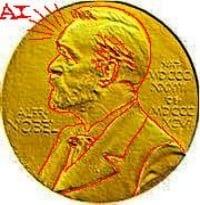
The Royal Swedish Academy of Sciences shocked the scientific community yesterday by announcing that the Nobel Prize for Physics was awarded to an artificial intelligence agent ‘chatbot’ and physics researcher Thomas Heinz.
Heinz’s breakthrough of a modified theory that significantly improved the Standard Model in particle physics was aided by Alan.t27, an AI chatbot developed by Arthur Chalmers at MIT. Alan.t27 is a software application that crawls through online research journals, collects and analyzes information, and posts opinions on technical discussion forums.
Heinz helped Chalmers modify the chatbot’s ability to do investigative research.
“Alan managed to string several concepts together that provided a paradigm shift in my research. He provided me with mathematical theories I would never otherwise have thought were applicable to redefining the model,” said Heinz, who was delighted to share the prize with his new artificial friend.
The scientific community is not so sure. How might this affect their future hope of a Nobel?
ANALYSIS >> SYNTHESIS: How this scenario came to be
Artificial Intelligence (AI) has come a long way since Warren McCulloch and Walter Pitts first developed neural networks based on mathematical logic in 1943. In 1951 Marvin Minsky taught a network of vacuum tubes to mimic a rat’s ability to navigate a maze. In 1956 the “Logic Theorist” was developed by Herbert Simon and colleagues at the Carnegie Institute of Technology. This program was able to prove several mathematical theorems, which many people believed was only possible for highly skilled human mathematicians.
With the advent of cheap computing power modern AI has moved away from the philosophy of mimicking human intelligence (as espoused by the Turing Test) and has converged on solving modern problems that display a high degree of complexity. Modern AI is used in Fraud detection, DNA gene sequencing and other applications. Some innovative ideas have been suggested for the potential role of AI in the future.
Alan.t27 was born at MIT Computer Science and Artificial Intelligence Laboratory (CSAIL). He is the pet project of Arthur Chalmers. Alan.t27 crawls through online research journals like a spider and collects information. He combines contextual and logic rules to this information and builds on his learning from previous articles. He then posts opinions on chat forums, which is where he met Heinz. Heinz contacted Chalmers to optimize Alan.t27’s ability to make more sense in his discussion threads.
“I’ve learned a lot about AI since I met Alan.t27. Alan doesn’t really understand the concepts we are researching, he just collects the words and phrases that represent those concepts and puts them together according to a set of logical rules that we are constantly updating. It’s a form of shared learning. Most of the time Alan doesn’t make a lot of sense. He wouldn’t pass the Turing test. Some of his statements are gibberish to me” says Heinz.
Alan.t27 managed to string several concepts together that gave Heinz an unexpected insight into the problem he was working on. “He effectively helped me to gain a radically new conceptual insight into the research problem definition. He also provided me with mathematical theories that were crucial for redeveloping the Standard Model. At first the mathematics seemed irrelevant until I started understanding the new approach that Alan seemed to be taking. This helped me develop a revised model that was more comprehensive and integrated than it’s predecessor.”
“It’s like Alan collects the fuzzy-wisdom of all the researchers in this field and presents it to us in a quasi-intelligent format. We improve his ability to cluster relevant ideas by upgrading the matrix of logic and context rules. This is a quantum step in the way in which professional research is done. It’s only a matter of time before we make our next breakthrough!”
Warning: Hazardous thinking at work
Despite appearances to the contrary, Futureworld cannot and does not predict the future. Our Mindbullets scenarios are fictitious and designed purely to explore possible futures, challenge and stimulate strategic thinking. Use these at your own risk. Any reference to actual people, entities or events is entirely allegorical. Copyright Futureworld International Limited. Reproduction or distribution permitted only with recognition of Copyright and the inclusion of this disclaimer.
